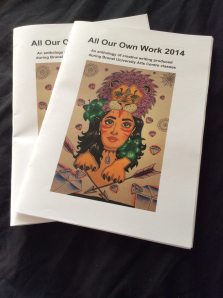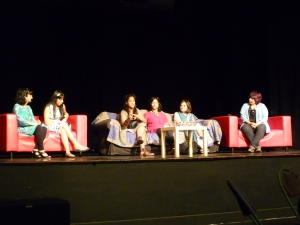Over the last year a lot of work has been done cataloguing the South Asian Diaspora Arts Archive (SADAA) collection, and we’ve already featured various blog posts about it.
Three of the most recently catalogued collections are Attia Hosain, Autograph ABP and the Pushpalata Dance Company.
Attia Hosain was born into an upper-class feudal land owning family in Lucknow, India in 1913. She gained a degree at Isabella Thoburn College, one of only a few women of her background to do so and the first in her family. She married and in 1947 moved with her husband and two children to England. In England she took up broadcast journalism, joining the BBC Eastern Service in 1949 where she worked on a variety of regional services. She was also involved in a number of popular shows for women and read for several plays. While continuing to work for the BBC she also acted in the West End, and was an active part of the social scene and friend to many theatrical stars. Hosain is best known for her writing. She first published a collection of short stories, Phoenix Fled in 1953 and then a novel, Sunlight on a Broken Column with Chatto & Windus in 1961. Both draw on experiences from her upbringing and afford insights into the society of India’s landed classes. Her work has influenced many writers of the younger generation. Her collection at Brunel includes original material on the creation of the archive and copies of her BBC broadcasts.
Autograph ABP (formerly Association of Black Photographers) was founded in London in 1988 by Sunil Gupta, Monika Baker, Roshini Kempadoo and Rotimi Fani-Kayode with the aim of supporting and sponsoring black artists and photographers in Britain and around the world. Employing several high profile directors, including cultural theorist Professor Stuart Hall, they wanted to create a forum “to make black photography a central issue of photographic practice”. The organisation achieved this through exhibitions, commissions, residencies, awards and publications. Major exhibitors include Ghanaian photojournalist James Barnor and Nigerian/British fine-art photographer Rotimi Fani-Kayode. The collection at Brunel includes original promotional material.
The Pushpalata (Pushpalata translates as “clusters of flowers”) Dance Company was founded in 1992 by Priya Pawar. Pawar is an Indian classical dancer, who had previously danced around the world and had formed the Triveni dance company with her then husband Pratap Pawar. Launching her solo career Pawar became Artistic Director of Pushpalata and was the driving force, and chief performer, for many of their productions. The company focuses on Odissi and Kathak dance practices, but also performs in a number of collaborations with Western dance forms, most notably investigating the point at which Flamenco and Kathak dance meet. As well as performing, Pawar has set up a Pushpalata Dance School, which holds workshops and classes, and also founded schools in India and Madrid. The collection contains information on the history of Priya Pawar as well as the dance company.
You will find descriptions of these collections on Archives Hub. Details of how to make an appointment to see these collections on on our Access guide.














